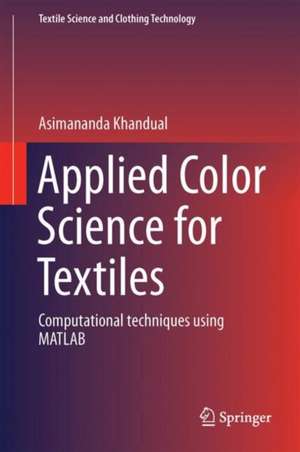Applied Color Science for Textiles: Computational techniques using MATLAB: Textile Science and Clothing Technology
Autor Asimananda Khandualen Limba Engleză Hardback – 13 iul 2021
Din seria Textile Science and Clothing Technology
- 18%
 Preț: 901.57 lei
Preț: 901.57 lei - 15%
 Preț: 580.68 lei
Preț: 580.68 lei - 15%
 Preț: 588.83 lei
Preț: 588.83 lei -
 Preț: 386.81 lei
Preț: 386.81 lei - 15%
 Preț: 460.75 lei
Preț: 460.75 lei - 18%
 Preț: 1010.33 lei
Preț: 1010.33 lei - 15%
 Preț: 710.75 lei
Preț: 710.75 lei -
 Preț: 385.47 lei
Preț: 385.47 lei - 15%
 Preț: 579.67 lei
Preț: 579.67 lei - 15%
 Preț: 573.79 lei
Preț: 573.79 lei - 15%
 Preț: 578.70 lei
Preț: 578.70 lei -
 Preț: 384.09 lei
Preț: 384.09 lei - 15%
 Preț: 517.67 lei
Preț: 517.67 lei - 15%
 Preț: 521.26 lei
Preț: 521.26 lei - 18%
 Preț: 785.11 lei
Preț: 785.11 lei - 18%
 Preț: 786.66 lei
Preț: 786.66 lei -
 Preț: 383.33 lei
Preț: 383.33 lei - 15%
 Preț: 573.97 lei
Preț: 573.97 lei -
 Preț: 386.39 lei
Preț: 386.39 lei - 19%
 Preț: 483.63 lei
Preț: 483.63 lei -
 Preț: 377.35 lei
Preț: 377.35 lei - 15%
 Preț: 642.18 lei
Preț: 642.18 lei - 15%
 Preț: 584.26 lei
Preț: 584.26 lei - 15%
 Preț: 639.73 lei
Preț: 639.73 lei - 18%
 Preț: 791.99 lei
Preț: 791.99 lei -
 Preț: 377.35 lei
Preț: 377.35 lei - 15%
 Preț: 642.68 lei
Preț: 642.68 lei - 15%
 Preț: 697.65 lei
Preț: 697.65 lei
Preț: 664.30 lei
Preț vechi: 730.00 lei
-9% Nou
Puncte Express: 996
Preț estimativ în valută:
127.12€ • 133.33$ • 105.82£
127.12€ • 133.33$ • 105.82£
Carte nepublicată încă
Doresc să fiu notificat când acest titlu va fi disponibil:
Se trimite...
Preluare comenzi: 021 569.72.76
Specificații
ISBN-13: 9789811073137
ISBN-10: 9811073139
Dimensiuni: 155 x 235 mm
Ediția:1st ed. 2021
Editura: Springer
Colecția Springer
Seria Textile Science and Clothing Technology
Locul publicării:Singapore, Singapore
ISBN-10: 9811073139
Dimensiuni: 155 x 235 mm
Ediția:1st ed. 2021
Editura: Springer
Colecția Springer
Seria Textile Science and Clothing Technology
Locul publicării:Singapore, Singapore
Cuprins
CHAPTER 1 INTRODUCTION
1. Introduction:
1 .1 What is color
1.2. The causes of color
1.3. Color constituents
1.4. Witt’s theory chromophores, auxochrome, chromogen
CHAPTER 2 COLORING MATTER
2.1. History : natural colors & synthetic dyes, chronological developments
2.2. Dyes and pigments
2.3. Brief on classification: chemical constitution and application
CHAPTER 3 DYEING
3.1. Dyeing theory
3.2. Application of various dyes to various fibres in brief
3.3. Some new dyes, developments, Applications
Chapter 4 MEASURING COLOR, PARAMETERS AND PECEPTION
4.1. History
4.2. Perception, Trichromaticity, Primary and secondary color
4.3 Opponent theory
4.4. Reflection, absorption, scattering, transmittance
4.5. Illuminant and observer, viewing geometry
4.6. Spectral Measurements techniques
4.7. RGB, XYZ, CIEL*a*b*, L*u*V*
4.8. Optical density , Beer Lambert’s Law , K/S & its use
4.9. CIE Diagram, Physical significance
CHAPTER 5: COMPUTATIONAL TECHNIQUES WITH MATLAB
5.1. Induction to basic commands
5.2. Computation and visualization of Spectral data and interpretation
5.3. More advanced computation: reflectance data to CIEL*a*b* of various illuminants & Observers, CIE diagram etc.
5.4. Exercises, solved examples for better understanding of spectral data, color parameters
CHAPTER 6: COLOR MIXING THEORY, PREDICTIONS
6.1 . Grassmann’s law , Kubelka-Munk theory, advances
6.2. Computer color Matching algorithms
6.3. Neural networks for color predictions
6.4. Metamerism, Fluorescence
6.5. Color Difference, Sorting and Error ellipse
6.6. Analysis and tips for producing exact color from data visualization
CHAPTER 7: IMAGING COLOR
7.1. Inside RGB sensors
7.2. Story of Device dependent color space
7.3. Interacting device independent to device-dependent color space
7.4. Color characterizations and modeling
7.5. Diffused illumination, modeling and rending
7.6. Advances and scope for textiles
7.7. Computation with MATLAB
CHAPTER 8: MORE EXERCISES, SOLVED EXAMPLES
Notă biografică
Dr. Asimananda Khandual is currently a faculty member at the Department of Fashion & Apparel Technology at the College of Engineering & Technology (CET), Bhubaneswar, India. Active in the field of textile research for 14 years, his primary research interests are in the areas of textile chemical processing, computational color science, image processing, modeling & artificial neural networks, novel functional finishes, e-textiles, and objective evaluation systems.
Textul de pe ultima copertă
This
book
provides
an
essential
overview
of
the
practical
use
of
color
science
for
textiles,
combining
theory,
examples,
illustrations,
and
lucid
computational
techniques
using
MATLAB
to
provide
readers
a
better
understanding
of
the
physical
significance
of
color
parameters.
It
includes
eight
chapters
on
conventional
applications,
with
a
special
chapter
on
the
use
of
digital
color
analysis
and
application
techniques
for
color
modeling,
recent
developments,
and
future
trends.
It
also
demonstrates
MATLAB
programming,
including
step-by-step
explanations
for
researchers
and
professionals
who
are
new
to
this
field.
Caracteristici
Highlights
Especially written
Includes exercises and solved examples
Especially written
Includes exercises and solved examples
